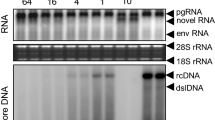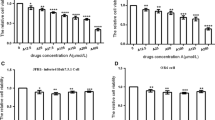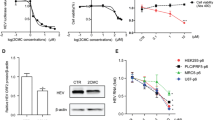Abstract
Nucleoside/tide analogs are now widely used for treatment of chronic hepatitis B (CHB). However, available nucleoside/tide analogs for treatment of CHB usually have limited therapeutic effect and potential adverse effects on CHB patients. We evaluated the anti-HBV effects of three novel derivatives (compounds 1, 4, and 8) of adefovir on the replication of hepatitis B virus (HBV) and determined their cytotoxicity. The effects of those compounds on the replication of human HBV in the HepG2 2.2.15 cell line and duck HBV in infected ducks were characterized by measuring the extracellular and intracellular HBV DNA using the quantitative real-time PCR and Southern blot assays. Their cytotoxicities against HepG2 cells were evaluated by MTT and measuring the contents of mitochondrial DNA using the dot blot assay. We found that all of the compounds inhibited the production of HBV in a dose-dependent manner, similar to that of adefovir dipivoxil. Furthermore, treatment with any of the compounds reduced significantly the replication of DHBV in ducks, accompanied by a significant reduction of inflammation in the livers, and the compound 1 appeared to be a fast-acting and long-lasting anti-DHBV reagent. Importantly, all of the compounds showed little cytotoxicity against HepG2 cells, even at a concentration of 1 mM. Collectively, those novel derivatives of adefovir had potent anti-HBV activity with little adverse effect and may be therapeutic candidates for potential clinical studies.






Similar content being viewed by others
References
Baek HJ, Lim SC, Kitisin K, Jogunoori W, Tang Y, Marshall MB, Mishra B, Kim TH, Cho KH, Kim SS, Mishra L (2008) Hepatocellular cancer arises from loss of transforming growth factor beta signaling adaptor protein embryonic liver fodrin through abnormal angiogenesis. Hepatology 48:1128–1137
Chan C, Abu-Raddad E, Golor G, Watanabe H, Sasaki A, Yeo KP, Soon D, Sinha VP, Flanagan SD, He MM, Wise SD (2005) Clinical pharmacokinetics of alamifovir and its metabolites. Antimicrob Agents Chemother 49:1813–1822
Chang TT, Lai CL (2006) Hepatitis B virus with primary resistance to adefovir. N Engl J Med 355:322–323 (author reply 323)
Chen CH, Cheng YC (1989) Delayed cytotoxicity and selective loss of mitochondrial DNA in cells treated with the anti-human immunodeficiency virus compound 2′,3′-dideoxycytidine. J Biol Chem 264:11934–11937
Chevallier M, Guerret S, Chossegros P, Gerard F, Grimaud JA (1994) A histological semiquantitative scoring system for evaluation of hepatic fibrosis in needle liver biopsy specimens: comparison with morphometric studies. Hepatology 20:349–355
Cui L, Yoon S, Schinazi RF, Sommadossi JP (1995) Cellular and molecular events leading to mitochondrial toxicity of 1-(2-deoxy-2-fluoro-1-beta-d-arabinofuranosyl)-5-iodouracil in human liver cells. J Clin Invest 95:555–563
Delaney WEt, Edwards R, Colledge D, Shaw T, Furman P, Painter G, Locarnini S (2002) Phenylpropenamide derivatives AT-61 and AT-130 inhibit replication of wild-type and lamivudine-resistant strains of hepatitis B virus in vitro. Antimicrob Agents Chemother 46:3057–3060
Dienstag JL (2008) Hepatitis B virus infection. N Engl J Med 359:1486–1500
Dusheiko G, Antonakopoulos N (2008) Current treatment of hepatitis B. Gut 57:105–124
Fan YF, Lu CC, Chen WC, Yao WJ, Wang HC, Chang TT, Lei HY, Shiau AL, Su IJ (2001) Prevalence and significance of hepatitis B virus (HBV) pre-S mutants in serum and liver at different replicative stages of chronic HBV infection. Hepatology 33:277–286
Feld JJ, Colledge D, Sozzi V, Edwards R, Littlejohn M, Locarnini SA (2007) The phenylpropenamide derivative AT-130 blocks HBV replication at the level of viral RNA packaging. Antiviral Res 76:168–177
Funk A, Mhamdi M, Hohenberg H, Heeren J, Reimer R, Lambert C, Prange R, Sirma H (2008) Duck hepatitis B virus requires cholesterol for endosomal escape during virus entry. J Virol 82:10532–10542
Gaillard RK, Barnard J, Lopez V, Hodges P, Bourne E, Johnson L, Allen MI, Condreay P, Miller WH, Condreay LD (2002) Kinetic analysis of wild-type and YMDD mutant hepatitis B virus polymerases and effects of deoxyribonucleotide concentrations on polymerase activity. Antimicrob Agents Chemother 46:1005–1013
Girard FC, Ottink OM, Ampt KA, Tessari M, Wijmenga SS (2007) Thermodynamics and NMR studies on duck, heron and human HBV encapsidation signals. Nucleic Acids Res 35:2800–2811
Gordon M (1996) Severe toxicity of fialuridine (FIAU). N Engl J Med 334:1136–1137 (author reply 1137–1138)
Kamiya N, Kubota A, Iwase Y, Sekiya K, Ubasawa M, Yuasa S (2002) Antiviral activities of MCC-478, a novel and specific inhibitor of hepatitis B virus. Antimicrob Agents Chemother 46:2872–2877
Lai CL, Yuen MF (2008) Chronic hepatitis B—new goals, new treatment. N Engl J Med 359:2488–2491
Lai CL, Gane E, Liaw YF, Hsu CW, Thongsawat S, Wang Y, Chen Y, Heathcote EJ, Rasenack J, Bzowej N, Naoumov NV, Di Bisceglie AM, Zeuzem S, Moon YM, Goodman Z, Chao G, Constance BF, Brown NA (2007) Telbivudine versus lamivudine in patients with chronic hepatitis B. N Engl J Med 357:2576–2588
Lok AS (2005) The maze of treatments for hepatitis B. N Engl J Med 352:2743–2746
Ono-Nita SK, Kato N, Shiratori Y, Carrilho FJ, Omata M (2002) Novel nucleoside analogue MCC-478 (LY582563) is effective against wild-type or lamivudine-resistant hepatitis B virus. Antimicrob Agents Chemother 46:2602–2605
Opii WO, Sultana R, Abdul HM, Ansari MA, Nath A, Butterfield DA (2007) Oxidative stress and toxicity induced by the nucleoside reverse transcriptase inhibitor (NRTI)-2′,3′-dideoxycytidine (ddC): relevance to HIV-dementia. Exp Neurol 204:29–38
Prince AM (1996) Severe toxicity of fialuridine (FIAU). N Engl J Med 334:1136 (author reply 1137–1138)
Quan DJ, Peters MG (2004) Antiviral therapy: nucleotide and nucleoside analogs. Clin Liver Dis 8:371–385
Schultz U, Grgacic E, Nassal M (2004) Duck hepatitis B virus: an invaluable model system for HBV infection. Adv Virus Res 63:1–70
Sekiya K, Takashima H, Ueda N, Kamiya N, Yuasa S, Fujimura Y, Ubasawa M (2002) 2-Amino-6-arylthio-9-[2-(phosphonomethoxy)ethyl] purine bis(2,2,2-trifluoroethyl) esters as novel HBV-specific antiviral reagents. J Med Chem 45:3138–3142
Soon DK, Lowe SL, Teng CH, Yeo KP, McGill J, Wise SD (2004) Safety and efficacy of alamifovir in patients with chronic hepatitis B virus infection. J Hepatol 41:852–858
Wang JQ, Fei X, Gardner TA, Hutchins GD, Zheng QH (2005) Synthesis of 2-amino-6-(4-[11C]methoxyphenylthio)-9-[2-(phosphonomethoxy)ethyl] purine bis(2,2,2-trifluoroethyl) ester as a novel potential PET gene reporter probe for HBV and HSV-tk in cancers. Bioorg Med Chem 13:549–556
Wu LL, Yang XB, Huang ZM, Liu HZ, Wu GX (2007) In vivo and in vitro antiviral activity of hyperoside extracted from Abelmoschus manihot (L) medik. Acta Pharmacol Sin 28:404–409
Yamada H, Suryanarayanan R (2007) X-ray powder diffractometry of intact film coated tablets—an approach to monitor the physical form of the active pharmaceutical ingredient during processing and storage. J Pharm Sci 96:2029–2036
Yuen MF, Tanaka Y, Shinkai N, Poon RT, But DY, Fong DY, Fung J, Wong DK, Yuen JC, Mizokami M, Lai CL (2008) Risk for hepatocellular carcinoma with respect to hepatitis B virus genotypes B/C, specific mutations of enhancer II/core promoter/precore regions and HBV DNA levels. Gut 57:98–102
Conflict of interest
All authors stated no conflict of interest.
Author information
Authors and Affiliations
Corresponding authors
Rights and permissions
About this article
Cite this article
Wu, D., Niu, JQ., Ding, YH. et al. Antiviral effects of three novel derivatives of adefovir on the replication of hepatitis B virus. Med Chem Res 21, 1179–1187 (2012). https://doi.org/10.1007/s00044-011-9616-2
Received:
Accepted:
Published:
Issue Date:
DOI: https://doi.org/10.1007/s00044-011-9616-2




